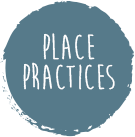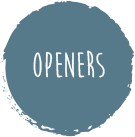

1. Tea and Coffee
This is a simple but integral opener to each of the sessions held at Oldham Theatre Workshop. Refreshments are offered and shared between the group and the space is set up with tables and chairs which are arranged in the same place within the room each time. Those returning become familiar with this arrangement and begin to help themselves, thus creating a familiar and accessible space for the group.
Sitting drinking tea and coffee allows for informal conversation between group leaders and the participants, as well as with each other. Sharing stories or even reflecting on the session before, this opener contributes to the positive building of relationships with both a new space and each other.
3. Getting to Know Each Other through Song
This opener is particularly useful in the early stages of the sessions. On arrival, each group member writes down his or her name and a greeting in his or her first language. To help the group familiarise themselves with their peers, the names and greeting are arranged into lyric format. Through musical accompaniment, the names and greetings are performed as a song to create a high-energy performance. This exercise offers a creative way of learning names whilst also acknowledging and celebrating the many different languages (and nationalities) in one room.
5. Improvised Storytelling with Props
A bag containing several everyday items is placed in the centre of the circle. The objects range from balloons to postcards, string to pegs. The group are asked to explore the items in their bags as they break away into smaller teams, discussing the functions of the items and how they could fit into a fictional story. Based on the items they must also create a character influenced by what they see in front of them. The exercise progresses into a whole group exercise where they must work together to create an original improvised story. This is not specifically on ‘place’ but encourages a new, non-specialist group to work creatively together in a non-threatening exercise.
7. Where have you been
This exercise consists of offering a large map of the borough, markers and stickers. The group is
asked to place a marking on the areas they have visited in Oldham. They are encouraged to be specific in
their placing, as it could be a building or street that is significant to them in that area.
The group can choose how to individually mark the map; this could be an initial, a symbol or even colour.
The exercise is completed at the beginning stages of the ‘intensive’ week of the project and revisited as
the week continues. This exercise is interesting because the participants find it sometimes impossible
to ‘locate’ their places of interest on a 2D map. They have not experienced Oldham through a mapping
process before. In some ways, it is not successful therefore as a ‘placing exercise’ for the participants
although it does offer an opportunity to point to other sites as the week’s intensive progresses.
2. Gels
The group are given a coloured lighting gel square. On this square, the group are asked to decorate the gel with something positive with which they have a personal connection. This could relate to their current mood, a favourite place, a memory … all done through illustration or text transferred directly onto the coloured gel. When the group have completed their creation, the gels are arranged together in a collage so they become one piece of art. At The Old Museum site (the home of Oldham Theatre Workshop) a window at the front of the building can be seen by the public as they walk past. Here the gels are placed into a section of the window that is ‘vacant’, with no other art work in it. The group become a part of the fabric of the building and are visually connected with the Old Museum.
Several of the Oldham Theatre Workshop ‘openers’ were linked to ideas of place, even if not made explicit. Others were simple drama exercises as most of the migrant drop-ins were not familiar with performance; a slow development was important.
4. Daily Routine through Sounds
The group begin with making a soundscape that reflects their daily routine. After they have experimented with different sounds they are then introduced to various instruments.
A table is created with each person’s name down the left. A grid for times throughout the day is formed by the across sections. On the table, the group are asked to demonstrate their daily routine through a visual line from left to right. The line might be straight to demonstrate calmness, or dashes and freehand swirls to exemplify chaos. Once the table has been completed, the group then use their instruments to perform their daily routine through music and soundscapes determined by tempo, volume and pitch. This offers a metaphorical entry into thinking about their place-routines.
6. Relating to images
A collection of entirely random images are placed in the space of Studio One floor. The group is asked to take a look at the images. In their own time they are asked to choose one image they connect with most. The connection could be anything from colours that reflect their current mood through to a particular landscape they like the look of. The group then shares with one another why they are drawn to a particular image. In sub groups of 3 or 4, they go on to create and share freeze frames of their own interpretation of the image. It is very broadly about place as well as a basic drama exercise.
In this exercise it became apparent that memory had influenced their choice of image. One group member explained that the picture reminded him of family and vacation time when he was a boy; another group member spoke of a memory of childhood. He explained that the amount of people in the image reminded him of playing with his friends as a little child and visiting the Mosque. The Place project did not set out to draw on people’s pasts. Participants occasionally chose to reference past memories, naturally and easily, and sometimes this would lead to past and present place connections.

